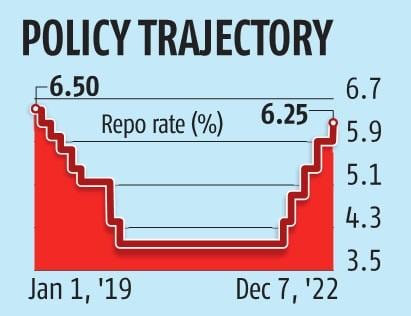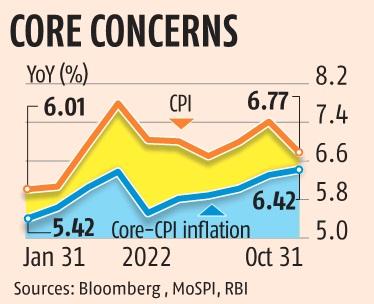RBI opts for smaller repo rate hike of 35 bps, hints at more to come
The six-member monetary policy committee (MPC) of the Reserve Bank of India (RBI) on Wednesday increased the policy repo rate by 35 basis points (bps) to 6.25 per cent, the highest level since February 2019. With this, the repo rate has been increased by 225 bps since May.
The increase was lower than the three previous ones, but the MPC hinted at the possibility of further hikes as it refused to lower its guard against inflation.
RBI Governor Shaktikanta Das cautioned that “the battle against inflation is not over”, while acknowledging that it was expected to moderate.
Average inflation has remained above 6 per cent for three consecutive quarters, which constituted a failure on the part of the central bank to meet its inflation mandate.
“…the MPC was of the view that further calibrated monetary policy action is warranted to keep inflation expectations anchored, break core inflation persistence and contain second round effects,” Das said, while announcing the review of the policy. He added: “The main risk is that core inflation remains sticky and elevated.”
The MPC’s external member Jayanth Varma voted against the increase, while both Ashima Goyal and Varma voted against the stance, which was to remain focused on withdrawal of accommodation.
“The governor explicitly noted that the resurgence in domestic services sector activity could also lead to price increases, especially as firms pass on input costs. Thus, the nature of inflation risks has in some sense moved from external factors to internal ones. This to us is the most hawkish aspect of today’s policy announcement,” said Suyash Choudhary, head – fixed income, IDFC AMC.
Though the hike was in line with expectations, the central bank’s comments were interpreted as hawkish as the market expected the MPC to indicate a pause after this hike. The yield of the 10-year benchmark government bond, which touched 7.3 per cent after Das’ comments, ended the day at 7.27 per cent, 2 bps higher than the previous close. The yields of the shorter-term papers hardened more sharply.

The market is now pencilling in another 25 bps rate hike in February.
“The RBI has down-shifted gears to 35 bps hike from 50 bps in the previous meetings, but yet to hit the brakes to bring the hiking cycle to a complete halt…We have a final hike in February of 25 bps, which remains a close call, and then a hold,” said Aurodeep Nandi, India economist and vice president of Nomura, while adding that the firm expects a cumulative 75 bps cuts in the second half of 2023, taking repo rates back to 5.75% by end-2023.
The RBI retained its projection for the consumer price index (CPI)-based inflation for FY23 at 6.7 per cent though the projections for Q3 and Q4 were increased slightly to 6.6 per cent and 5.9 per cent, respectively. CPI inflation for Q1FY24 was projected at 5 per cent and for Q2 at 5.4 per cent.
Das sounded more sanguine on gross domestic product (GDP) growth, though the projection for FY23 was lowered slightly to 6.8 per cent from 7 per cent. Real GDP growth is projected at 7.1 per cent in Q1FY24 and 5.9 per cent in Q2.
As nearly 50 per cent of fresh loans are linked to external benchmarks, mostly the repo rate, home loans and car loans are set to get dearer.
Soon after the RBI’s decision, state-run lender Bank of India increased the repo-based lending rate by 35 bps to 9.1 per cent. Others are expected to follow suit.

“With about 47 per cent of the loans benchmarked to external benchmarks (EBR), the increase in repo rate of 225 bps (including today’s 35 bps hike) will eventually increase interest cost further,” said Soumya Kanti Ghosh, Group Chief Economic Adviser, State Bank of India.
“Our analysis indicates that due to this rate hike cycle, interest cost of retail and MSME consumers will increase around Rs 68,625 crore. This may impact demand,” Ghosh added.
 Loan, Personal Loan, Home Loan, Business Loan,Loans in India Loan in India, Personal Loan, Home Loan, Business Loan, Loans in India,Loan Finance,Loan in India, Get Instant Personal Loan,Home Loan, Business Loans in India
Loan, Personal Loan, Home Loan, Business Loan,Loans in India Loan in India, Personal Loan, Home Loan, Business Loan, Loans in India,Loan Finance,Loan in India, Get Instant Personal Loan,Home Loan, Business Loans in India